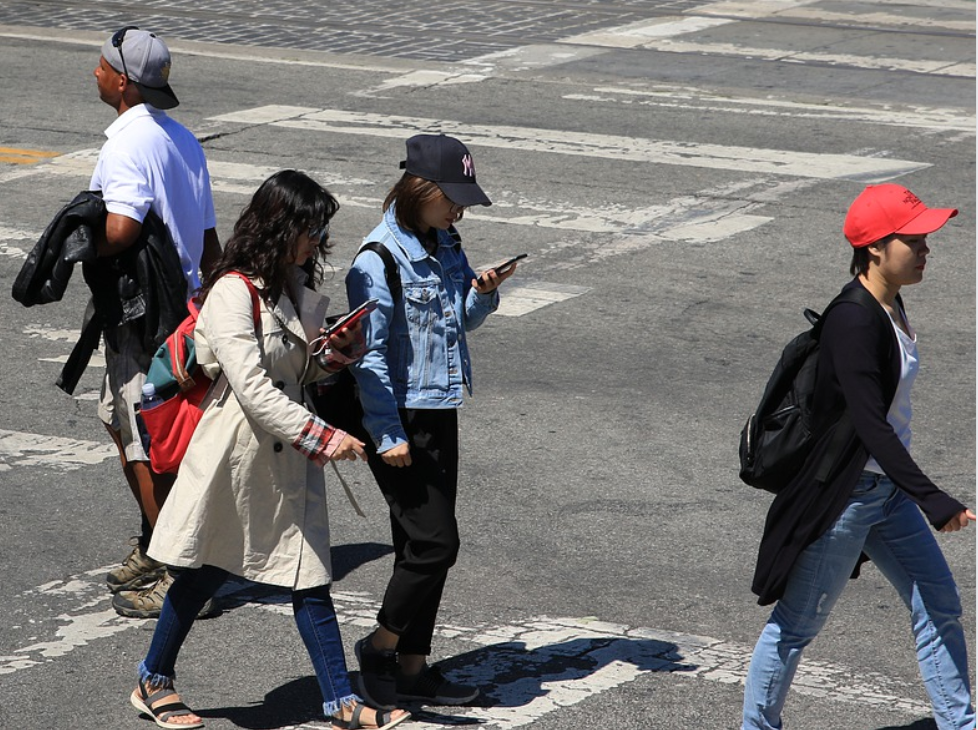Almost a third of those who plan our road networks think that "distracted walking" is a leading factor in pedestrian deaths — and a new study argues that it's distracting them from finding solutions to mitigate the real threat to walkers: dangerous driving.
Researchers from Rutgers University surveyed transportation practitioners nationally and found that 30 percent believed that distracted walking was a "big problem" for traffic safety. Even worse, that group attributed 40 percent of pedestrian deaths to distracted walking — even though distracted walking doesn't even make the CDC's list of top factors that contribute to traffic violence.
Practitioners who primarily get around by car and spend little time in pedestrian areas were more likely to over-estimate the effect of distracted walking — a phenomenon that lead researcher Kelcie Ralph dubbed "windshield bias."
The study also found that these gross misconceptions influenced how our cities actually get built. Transportation professionals who were concerned about distracted walking were also more likely to support educating walkers about "safe" walking behaviors, and less likely to support reducing driver speeds — even though driver speed is among the strongest predictors of pedestrian mortality.
"Education and enforcement are less effective, are susceptible to police bias, and are inconsistent with Vision Zero," said Ralph in a tweet. "If our approach is to chastise distracted peds, streets will remain unsafe for children, the elderly, and blind people, who each face risks similar to distraction."
The idea that "distracted walking" is a major safety hazard is an out-and-out myth, as Streetsblog has extensively documented. Although walkers sometimes experience distraction, vanishingly little evidence exists to support the claim that distracted walkers actually cause crashes that hurt anyone — including themselves.
Years of studies since the advent of the automobile have turned up no conclusive evidence that "distracted" walkers are more likely to wander into roadways unawares, whether those distractions take the form of talking on phones, listening to music, texting, helping a child tie a shoe, or otherwise paying attention to anything besides their immediate surroundings. Studies on specific "dangerous" pedestrian behaviors, such as failing to look both ways before crossing a street that's designed primarily for driver speed, have not yet discovered that "distraction" was a strong predictor of which walkers would engage in those behaviors.
Do distracted peds look right and left less often?
— Kelcie Ralph, PhD (@KMRalph) May 12, 2020
Do they miss opportunities to cross?
Do they walk more slowly?
Do they get ‘hit’ in simulators more often?
Despite several studies, the answers remain unclear.
But perhaps the most persuasive aspect of the report was a simple reminder about recent history: Although "distracted walking" is commonly blamed on the invention of the smart phone, 61,000 pedestrians were injured and 4,784 were killed in 2006 — the year before smart phones were introduced to consumers. And there are better-proven explanations for why pedestrian deaths have skyrocketed in recent years, from soaring SUV sales to population growth in car-dominated states with the road networks that most neglect walker safety and encourage driver speeding.
So why is the myth that distracted walking kills so pervasive — to the point where even highly educated transportation professionals believe it, and let that misperception inform their road-design, service and policy decisions?
Ralph points to several key reasons, which boil down to two depressing realities: 1) it's really easy to blame dead victims, because they can't speak for themselves, and 2) cars and the world we build around them make a lot of people a lot of money.
3) Despite the weak evidence base, people buy into the idea of distracted walking bc it is an intuitive idea that has garnered considerable press. Thanks to the illusory truth effect, we tend to believe ideas that get repeated over and over.
— Kelcie Ralph, PhD (@KMRalph) May 12, 2020
Plus, both the automotive industry & transport practitioners have strategic reasons to embrace the idea of distracted walking: it narrows the call to action.
— Kelcie Ralph, PhD (@KMRalph) May 12, 2020
If distraction is the cause of ped deaths, we don’t have to address oversized SUVs or fundamentally rethink road design.
We'd also add: a legal system that also systematically absolves drivers of responsibility in almost all crashes and defaults to victim-blaming if they blame anyone at all, politicians who echo those distortions in public addresses, and national vehicle-safety standards that only consider the safety of human beings inside cars — sending a clear message that pedestrians' survival is their responsibility alone. Then there's a media landscape that still refers to all crashes as "accidents", and... you know what, let's just say, we could go on.
But we don't have anything to add to Ralph's conclusion, which is dead on.
In short, distracted walking is a catchy concept, but is responsible for an unknown, but almost certainly small, share of ped deaths.
— Kelcie Ralph, PhD (@KMRalph) May 12, 2020
Don’t buy into the hype.
Instead, tackle the known killers of peds: high speeds, distracted/impaired driving, and unsafe road design.






